MOJ
eISSN: 2573-2919


Mini Review Volume 9 Issue 1
1Faculty of Forestry (FCF), Autonomous University of Nuevo Leon (UANL), México
2University of Applied Science Neubrandenburg, Germany
Correspondence: Dr. Maria dlA Rechy von Roth, Faculty of Forestry (FCF), Autonomous University of Nuevo Leon (UANL), México, Tel 49407202219
Received: January 05, 2024 | Published: January 29, 2024
Citation: Roth MR, Roth W. Insulating materials for the construction of houses with natural fibers of Yucca spp., Agave lechuguilla and Super absorbent synthetic fibers. MOJ Eco Environ Sci. 2024;9(1):6-10. DOI: 10.15406/mojes.2024.09.00300
The building physics aspects for thermal insulation in building construction are presented in brief. Different demands are placed on the thermal insulation material. In addition to the thermal insulation capacity, the price and the regional availability are important. From this perspective the use of fiber plants occurring in the semi-desert (semi-arid) zones of Mexico and an industrial waste material is being investigated.
Keywords: insulation materials, semi-desert zones of Mexico, natural fiber plants, industrial waste material
The materials for the current construction industry of houses in the north of Mexico and other parts of Latin America are not suitable for semi-desert areas, where in the summer there are temperatures above 40°C and in the winter down to below zero. The material used is normal concrete (concrete) and in some regions mud (adobe), but in much smaller quantities, this is due to various disadvantages of this material, although in terms of insulation it is not very good.
In cities, concrete is used for walls in the form of blocks and for roofs in the form of slabs. The mud in the towns is used for walls, the roofs are made of galvanized sheet, which makes the temperatures in winter and summer even worse.
For this reason and seeing that there are natural resources that are not used for this purpose, research was initiated to make various materials from different mixtures, in order to obtain varied densities and therefore different coefficients of thermal conductivity (λ).
Generalities
Table 1 shows the thermal conductivity and compressive strength of various traditional building materials:
|
Material |
Density ρ (g/cm3) |
Thermal conductivity λ (W/(K∙m) |
Compressive strength β (MPa) |
|
Normal concrete |
2.4 |
2.1 |
Oct-60 |
|
Light concrete |
0.8 – 2.0 |
0.39 – 1.60 |
12-Feb |
|
Pumice concrete |
0.5 – 1.2 |
0.15 – 0.44 |
8-Feb |
|
Aerated concrete |
0.4 – 0.8 |
0.14 – 0.23 |
8-Feb |
|
Brickmasonry |
1.2 – 2.0 |
0.50 - 0.96 |
10-Apr |
|
Coniferouswood |
0.35 – 0.55 |
0.13 |
30 - 50 |
|
Hardwood |
0.50 – 0.90 |
0.2 |
40 - 80 |
|
Polyurethanefoam |
0.02 – 0.035 |
0.025 – 0.035 |
0 |
|
Polystyrenfoam |
0.025 – 0.04 |
0.025 – 0.040 |
0 |
|
Glassyfoam |
0.1 – 0.2 |
0.04 – 0.06 |
1.2 |
|
Adobe (mudbricks) |
1.8 – 2.0 |
0.9 – 1.0 |
2 – 3.5 |
|
Light mud |
0.6 – 1.2 |
0.4 – 0.7 |
0 |
|
Dry air,motionless |
0.0012 |
0.025 |
0 |
|
Water |
1 |
0.6 |
0 |
Table 1 Densities, thermal conductivity and compressive strength of various materials for construction¬
Dry air without movement (static air) is the best insulating medium. As a consequence, porous materials (with dry static air in the pores) have low thermal conductivity, but also low mechanical resistance. The thermal storage capacity depends on the mass of the material used. Dense materials can retain ambient temperatures for a long time and when their density increases, so does the mechanical resistance.
The thermal conductivity of water is about 24 times greater than the conductivity of air. Replacing air with water (moisture content of the material) results in an increase in thermal conductivity, which is why all buildings need good protection against humidity.
Lightweight concrete blocks
Lightweight concrete (Figure 1) is produced by using lightweight materials instead of heavy gravel and sand. The most common are:
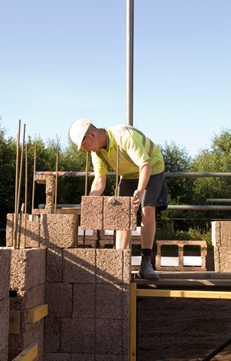
Figure 1 Wall with lightweight concrete blocks of wood chips.1
Wood chip concrete has a low thermal conductivity, λ ≈ 0.15 W/(K∙m). The relatively low compressive strength can be compensated by thick solid block walls or filling the block voids with normal concrete. The best thermal behavior is obtained when the gaps in the blocks are filled with insulating material such as polystyrene, polyurethane, perlite, vermiculite, mineral wool, vegetable wool, animal wool and others.
Light or normal concrete blocks do not usually need to be filled with concrete. In this case the static air in the voids of the blocks can serve as an insulating layer. To prevent internal air circulation, the upper side of the blocks must be closed (Figure 2).
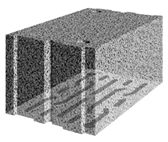
Figure 2 Lightweight pumice concrete block with closed holes on the upper side.2
Water content in constructions
The enemy of all constructions is high moisture content. Moisture can penetrate a building through:
The penetration of external moisture can be avoided with facades and roofs that are impermeable to rainwater. Condensation of interior moisture on walls can be avoided with good insulation in combination with vapor barriers. These waterproof vapor barriers are placed on the interior side in cold areas (heated houses), or on the exterior side in hot areas (cooled houses).
Figure 3 shows the measures necessary to prevent soil moisture from penetrating a building by capillarity.
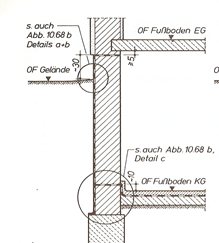
Figure 3 Barriers against soil moisture.3
In Mexico, the necessary insulation against rising humidity is generally not sufficiently considered, especially they do not place a horizontal barrier between the foundations and the walls of the first floor.
Types of construction elements with good thermal properties
There are mainly two possibilities to achieve good thermal protection:
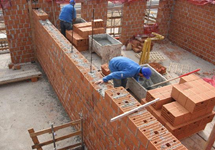
Figure 4 Single-layer load-bearing walls (porous bricks) with good thermal insulation properties.4
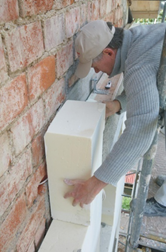
Figure 5 Exterior wall with separation of the load-bearing layer and the thermal insulation layer (two-layer wall). In hot climates, the insulating layer is very advantageously placed on the interior side, in cold climates on the exterior side of the home.5

Figure 6 Three-layer exterior wall.4
Sheets of expanded polystyrene, polyurethane or mineral fibers made of rock or glass are generally used as materials for the insulating layer.
Outer layer as a layer of protection against the weather exposure. Intermediate layer as a thermal insulating layer (central insulation). Inner layer as a supporting layer. Termites easily destroy insulation plates made of organic material, which is why good protection is necessary between the concrete of the floor and the wall, for example with metal plates.
Instead of insulating layers, loose material such as perlite, vermiculite, polystyrene granules or animal wool (sheep, alpacas, etc.) or plant fibers can also be used. Animal wool or plant fibers always need a hydrophobic (against humidity) and fungicide (against fungi) pretreatment.
Choice of insulating materials
The choice and degree of insulation is based on a series of factors:
In cold climates, the insulating layer is placed on the outside, to stop heat loss to the outside and store the heat produced by heating in the walls, floors and heavy ceilings inside. On the contrary, in hot climates, the thermal insulation layer is placed on the interior side, to stop the penetration of heat inward during the day and absorb ambient heat in the walls, floors and heavy ceilings. These solid elements can be cooled during the night and no energy is lost to air condition the solid elements during the day.
Generally, a combination of materials results in optimal building solutions, but it is necessary to analyze each situation and choose the appropriate material.
Unusualinsulatingmaterials:
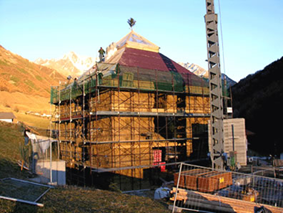
Figure 7 Construction of a house with straw bale walls in Switzerland.6
Taking the above into account, various natural resources and waste materials from various industries were chosen, testing different mixtures: with cement, plaster, mud or lignin as a natural component of plant fibers.
Alternative insulating materials for semi-desert areas in Mexico
Within the framework of the efforts of the Wood Technology Department of the Faculty of Forestry Sciences (FCF) of the Autonomous University of Nuevo León (UANL),7 the researcher Rechy de von Roth M8 (Estudio integral de 5 especies de Yucca), Juarez Alvarado C7 (Mezclas de fibras de Lechuguilla con concreto), looked for alternatives to the use of traditional construction materials that had good thermal properties, for which she used natural fibers and waste from diaper manufacturing.
The multiple use of Agaves and Yuccas fibers has a long tradition in Mexico. In recent decades, these fibers have also been used as reinforcement for concrete, mortar or clay elements. This use is very interesting, especially because in the semi-desert areas of Mexico, Agaves and Yuccas grow wild. In these areas there are few sources of work and therefore, labor is cheap. The traditional international market for these fibers, known as Tampico Fibers (Ixtle), is displaced by synthetic fibers. The increase in the use of Ixtle is necessary to preserve these sources of work in the areas mentioned above.
In modern buildings, biological and ecological materials are preferred. In this sense, the use of Ixtle, especially without additional binder or in combination with mud, allows the production of very modern building elements with great possibilities in the international market. The use of cement or gypsum as a binder is controversial in the ecological sense, but both are not harmful to health.
In the manufacture of diapers for children or incontinence pants for the elderly there are strict quality controls, large quantities of these products do not pass quality control. To date there are few uses for this industrial waste. The absorbent material (about 75% of the diaper mass) is a mixture of cellulose flakes and superabsorbent polymers (Figure 8). These superabsorbent polymers bind liquids and transform into a gel. This gel/cellulose mixture is currently used in gardening, but there is also some potential to use it as a lightweight aggregate for construction materials. In these investigations, various mixtures were made, as can be seen in Table 2.
Lechuguilla and Yucca fibers contain up to 10% lignin,8 which can be activated as glue by heat treatment of the fibers. Lignin plasticization begins at temperatures > 80ºC. Total plasticization requires temperatures > 160ºC and pressures > 100 bar. Preliminary investigations showed that temperatures of 90ºC and low pressures of 0.15 bar are necessary to plan the surface of the plates, allowing the production of insulating plates without additional binders.
With the pressure applied in the production of the insulating plates and the binder content, the density can be controlled and with it, the thermal conductivity of the plates. Table 2 shows the results of the tests that have been done. An exact description of the manufacturing and testing of the specimens is found in the final report by Rideau.9
The test pieces were made with dimensions of 30x30 cm² and a thickness of 5cm on average and dried to a moisture content of approximately 12% at the Faculty of Forestry Sciences (FCF) of the Autonomous University of Nuevo León/Mexico (UANL) (Figure 9).7
Figure 10 shows a forced circulation mixer, which is needed to mix cement with extremely light materials.
The tests to determine the thermal conductivities were done at the University of Applied Sciences Neubrandenburg/Germany. The specimens were cut to exactly 20 x 20 cm², the surfaces were adjusted in thickness using a planning machine (grinding machine) to be exactly parallel (Figure 11).
To ensure that the heat flow was uniform, the gaps on the surfaces of the specimens were filled with plaster (Figure 12). The influence of this measurement was considered in determining the theoretical thermal conductivity.
The specimens prepared and dried to a moisture content of 12% were placed between a heated plate (emitting plate) and an unheated plate (receiving plate) (Figure 13). The flow of energy allows the determination of thermal conductivity.
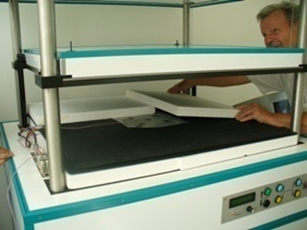
Figure 13 Apparatus for determining the thermal conductivity of construction materials (Rechy, von Roth).
Table 2 shows the results of these tests with specimens prepared in Mexico, the thermal conductivity (λ) was determined in Neubrandenburg/Germany.
|
Board No. |
Materials |
Amount of insulation (g) |
Gluequantity (g) |
Density g/cm³ |
λ (W/K∙m) |
|||
|
Honeycomb |
Fibers |
Cement |
Plaster |
Mud |
||||
|
*1 |
Lechuguilla fibers |
200 |
0.14 |
|||||
|
*2 |
Lechuguilla fibers |
700 |
0.15 |
0.06 |
||||
|
*3 |
Lechuguilla fibers |
950 |
0.15 |
0.07 |
||||
|
*4 |
Lechuguilla fibers+cement |
200 |
1000 |
0.7 |
0.165 |
|||
|
*5 |
Lechuguilla fibers+cement |
200 |
1000 |
0.8 |
||||
|
*6 |
Lechuguilla fibers+cement |
200 |
1150 |
0.85 |
||||
|
*7 |
Lechuguilla fibers+cement |
200 |
100 |
0.9 |
0.17 |
|||
|
8 |
Lechuguilla fibers+plaster |
200 |
870 |
0.65 |
||||
|
9 |
Yucca fibers |
450 |
0.13 |
0.06 |
||||
|
10 |
Yucca+mud fibers |
200 |
1150 |
1 |
||||
|
* 11 |
Diaper+cement |
160 |
600 |
0.5 |
0.075 |
|||
|
12 |
Diaper+cement |
200 |
1500 |
0.85 |
0.19 |
|||
|
13 |
Diaper+plaster |
200 |
700 |
0.55 |
0.1 |
|||
|
14 |
Diaper+plaster |
200 |
|
|
1000 |
|
0.75 |
0.175 |
Table 2 Investigated mixtures and their thermal conductivity λ
*Considering the technical properties and estimated production prices (Rideau, 2009), these boards seem to be interesting and further research is proposed.
Very interesting results were found with Lechuguilla fibers. These products can only serve as insulation. The low production costs with these fibers would allow the development of a good market for this type of insulation in Mexico, taking into account that the majority of rooms in the country are not insulated due to lack of money and knowledge in building physics.10–15
Considering the current prices of labor, binders, aggregates (in Mexico) and the manual processing of the products,9 only half of the products analyzed seem interesting for use in construction. Table 3 shows the thermal conductivity coefficient of these products. But the results show that the use of industrial or rural waste has great potential in the construction materials industry.
|
Board No. |
Density ρ (g/cm³) |
Thermal conductivityλ (W/K∙m) |
|
2 |
0.15 |
0.06 |
|
3 |
0.15 |
0.07 |
|
4 |
0.7 |
0.165 |
|
7 |
0.9 |
0.17 |
|
9 |
0.13 |
0.06 |
|
11 |
0.5 |
0.075 |
|
12 |
0.85 |
0.19 |
|
13 |
0.55 |
0.1 |
|
14 |
0.75 |
0.175 |
Table 3 Thermal conductivity λ of lechuguilla and diaper fiber boards
None.
None.
The authors declare no conflict of interest in writing the manuscript.

©2024 Roth, et al. This is an open access article distributed under the terms of the, which permits unrestricted use, distribution, and build upon your work non-commercially.